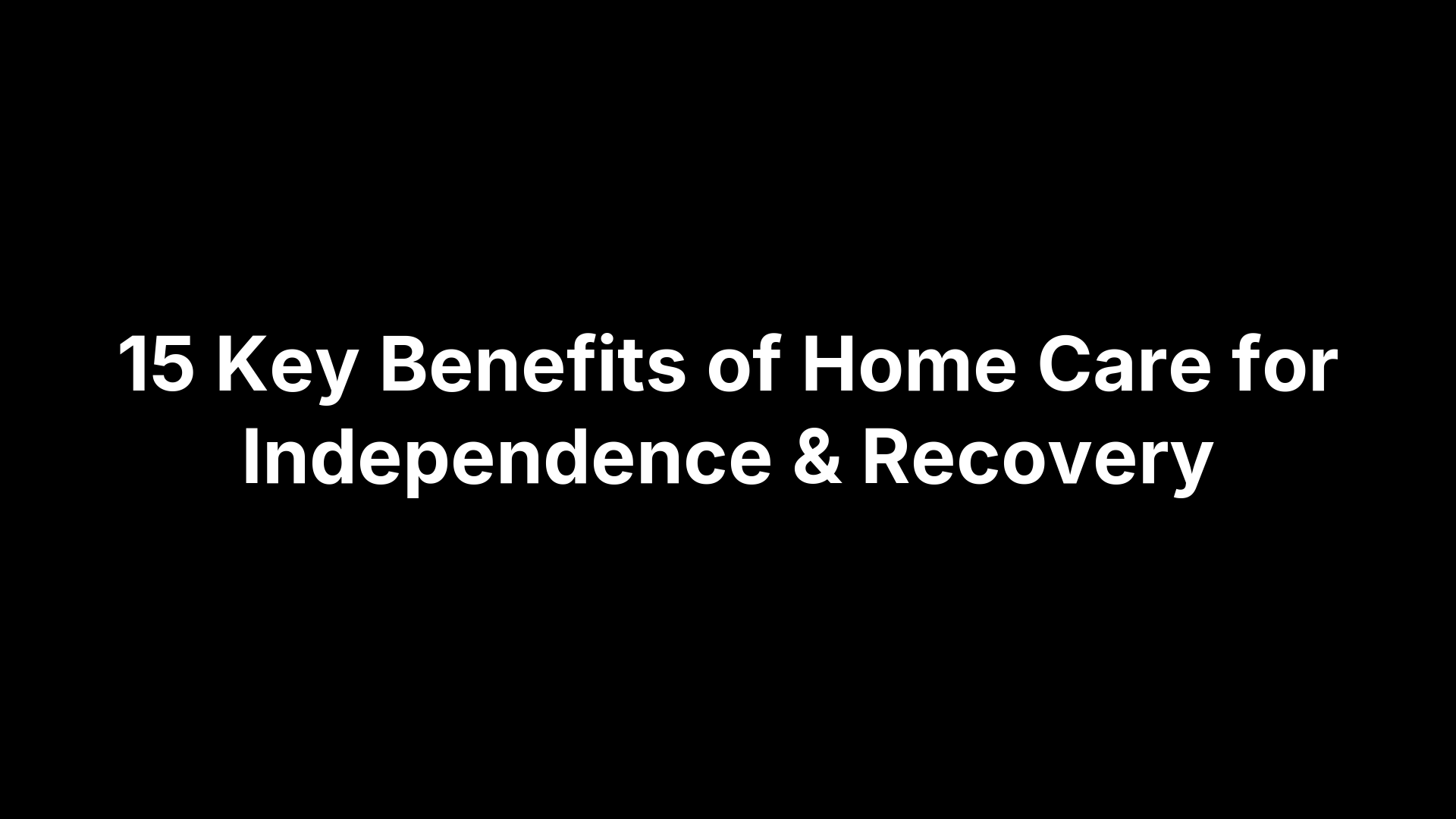15 Key Benefits of Home Care for Independence & Recovery


15 Key Benefits of Home Care for Independence & Recovery
Picture finishing your physical-therapy session at the kitchen table while a familiar song plays in the next room. A licensed nurse checks your vitals, updates the electronic chart, and then your grandchild joins you for lunch—all without a single hallway or hospital alarm in sight. That mix of professional care and personal comfort is why more families are choosing home care when recovering from surgery, managing chronic conditions, or supporting an aging parent.
Home care covers both non-medical assistance—help with bathing, meals, and errands—and Medicare-covered skilled services delivered by nurses and therapists. Together they create a tailored safety net that puts the individual, not the institution, at the center of every decision. The 15 benefits that follow show how this approach protects independence, accelerates healing, trims costs, and gives caregivers room to breathe. Use them as a checklist as you decide whether arranging support at home is the right next step.
1. Greater Independence: Staying in Control of Daily Life
Independence tops every survey of what older adults value most. A Johns Hopkins study found seniors receiving in-home support maintained 13% higher Activities of Daily Living (ADL) scores than peers in facilities, underscoring the primary benefits of home care.
How Home Care Supports Self-Directed Routines
Morning wake-ups, meals, hobbies, and video calls happen on the client’s clock, not a nurse’s station schedule, honoring cultural or religious routines.
Adaptive Equipment & Minor Home Modifications
Simple add-ons—grab bars, shower chairs, smart lights—boost self-sufficiency; Medicare or Medicaid often covers durable equipment when clinically ordered.
Preventing Dependence Spiral
Staying in charge guards against the “dependence spiral,” lowering depression risk and helping cognition remain sharper for longer.
2. Faster Recovery & Fewer Hospital Readmissions
Centers for Medicare & Medicaid Services data show post-acute patients treated at home recover almost one-third faster and see readmission rates drop by roughly 25%. Healing where you sleep lowers infection exposure, and connected monitoring devices give clinicians real-time insight—proof that the benefits of home care reach well beyond simple convenience.
Skilled Care at the Bedside—Literally
Registered nurses and PT/OT/ST teams deliver IV therapy, wound care, and strength training right in the living room, backed by Bluetooth stethoscopes and remote pulse-ox tracking.
Bridging the Hospital-to-Home Transition
Coordinated discharge plans arrange equipment, reconcile medications, and book follow-ups before the patient even reaches the driveway, closing dangerous care gaps.
Avoiding Re-Hospitalizations
Teach-back coaching for CHF, COPD, and diabetes flags red-zone symptoms early; same-day clinician tweaks head off most emergency-room returns.
3. Personalized, One-to-One Care Plans
Cookie-cutter protocols don’t cut it when every body—and household—is different. One of the biggest benefits of home care is the ability to create a plan that revolves around the individual, not a facility flowchart. From the first visit, the team tailors services to the client’s goals, living space, and support network.
Holistic Assessment Process
Clinicians evaluate physical status, mood, social supports, and the home environment to design truly whole-person care.
Flexible Goal Setting & Continuous Re-evaluation
Weekly check-ins and case reviews let therapists dial care up or down as recovery milestones are met or new issues appear.
Family & Patient as Core Team Members
Loved ones join daily decisions, improving adherence and ensuring the plan always respects personal preferences and cultural values.
4. Enhanced Safety & Fall Prevention
One of the underrated benefits of home care is that healing at home slashes exposure to hospital infections, yet loose rugs or dim halls still threaten recovery. Home-care teams spot and neutralize hazards early.
In-Home Safety Audits
Nurses review lighting, clutter, throw rugs, and handrails, then prescribe fixes from nightlights to grab bars.
Proactive Fall-Risk Training
Therapists teach balance drills, safe transfers, and proper cane or walker use—skills proven to cut falls.
Disease-Specific Safety Protocols
Customized plans add door alarms for dementia wanderers or pulse-ox/bronchodilator kits for COPD flare-ups.
5. Comfort of Familiar Surroundings
Healing isn’t just clinical; it’s deeply sensory. Seeing familiar photos and smelling morning coffee where it’s always brewed signals safety, lowering cortisol and blood pressure.
Reduced Stress & Better Sleep
Quiet bedrooms free of alarms enable deeper sleep that speeds tissue repair and dulls pain.
Support of Family, Friends & Pets
Petting the family dog or clutching a beloved quilt releases oxytocin, easing anxiety for everyone.
Maintaining Community Connections
Porch chats, neighborhood walks, and virtual services keep social ties strong, warding off facility isolation.
6. Cost Effectiveness Compared With Facility Care
Sticker shock is real: national surveys peg skilled-nursing facilities at about $325 a day and assisted living around $175. One of the financial benefits of home care is that intermittent skilled visits average roughly $180—and you pay only when services are delivered.
What Medicare, Medicaid & Private Insurance Cover
Medicare covers part-time nursing, therapy, and approved DME for “homebound” patients; Medicaid waivers and many PPOs mirror this.
Pay-As-You-Need Flexibility
Agencies bill by the hour, day, or visit, so families avoid the all-inclusive facility rate when needs fluctuate.
Financial Impact on Families & Tax Benefits
Tax deductions for medical expenses and employer elder-care benefits can offset out-of-pocket co-pays.
7. Relief & Support for Family Caregivers
Caregiver burnout is real; rotating professional help shields spouses and adult children from exhaustion, absenteeism at work, and the guilt that piles on with 24/7 vigilance.
Scheduled Respite Breaks
Agencies can slot in an aide for a four-hour bath-and-meal shift or an entire weekend, giving relatives time to sleep, work, or simply recharge.
Education & Skills Training for Families
RNs demonstrate wound dressing, safe transfers, and medication setups, then watch caregivers practice until everyone feels confident.
Emotional Support & Community Resources
Social workers connect families to online forums, local support groups, and respite grants—proof they don’t have to do this alone.
8. Continuity of Care Across Providers
Home care keeps every provider on the same page. Shared electronic charts and tight agency networks mean orders update instantly, preventing duplicate tests and ensuring medication tweaks actually happen.
Consistent Care Team
Seeing the same nurse and aide each week builds trust and catches small changes.
Technology-Driven Coordination
HIPAA-secure apps and EHR links let hospitalists and home clinicians coordinate in real time.
Reduced “Shift” Gaps
With schedules set weeks ahead, home care avoids the revolving-door staffing common in facilities.
9. Effective Management of Chronic Conditions
Chronic illnesses—heart failure, COPD, diabetes, dementia—demand consistent, nuanced attention that busy clinics can’t match. In-home teams create living, breathing care maps that evolve daily, preventing minor hiccups from ballooning into hospital stays and illustrating some of the most practical benefits of home care.
Disease-Specific Protocols at Home
Customized glucose logs, weight diaries, and memory prompts align with evidence-based guidelines for each diagnosis.
Early Symptom Detection & Escalation Pathways
Daily vitals and red-flag checklists trigger nurse calls or 911 escalation long before crises hit.
Lifestyle Coaching in Real-Life Context
Nutrition tweaks happen in the actual pantry; exercise plans use hallway steps, making habits stick.
10. Medication Management & Adherence
WHO says roughly half of adults with chronic disease miss doses or quit prescriptions. Medication oversight is therefore one of the biggest benefits of home care. Nurses turn complex regimens into simple, fail-safe habits.
Medication Reconciliation After Discharge
RNs match discharge lists to home bottles, erase duplicates, and verify doses with the doctor.
Pillbox Setup, Alarms & Smart Dispensers
Color-coded pillboxes, phone alerts, and Wi-Fi dispensers cue each dose and prevent double-taking.
Monitoring Side Effects & Efficacy
Daily vitals plus symptom check-ins reach clinicians instantly, so therapies adjust before side effects snowball.
11. Skilled Therapy Services Delivered at Home
In-home physical, occupational, and speech therapy—covered by Medicare Part A/B—brings clinic-grade care to the living room, accelerating recovery without the facility price tag.
Functional Goals Tied to Real Tasks
Therapists use the patient’s own stairs, shower, and kitchen to practice tasks that matter day-to-day.
Reducing Transportation Barriers
Skipping rides and waiting rooms keeps attendance high and progress on schedule.
Adaptive Equipment Training
Patients master wheelchairs, reachers, and grab bars where they’ll actually use them.
12. Companionship & Mental Health Benefits
Loneliness rivals smoking as a health risk, yet home-bound patients can slip into it fast. Among the key benefits of home care is built-in companionship that lifts mood, sharpens cognition, and even strengthens immunity.
Meaningful Engagement Activities
Aides read books, bake family recipes, or stream favorite concerts and games.
Monitoring Mood & Cognitive Changes
Familiar staff catch appetite, speech, or memory changes and alert nurses quickly.
Facilitating Tele-Behavioral Health Visits
They handle tablets and log-ins, ensuring virtual therapy happens privately and on time.
13. Flexible Scheduling and Scalability of Services
One of the unsung benefits of home care is its adjustable-thermostat scheduling—services rise during setbacks and ease off when health stabilizes, keeping support aligned with real-time needs and budgets.
Hourly to 24/7 Coverage Options
A knee-replacement patient may start with 24-hour nursing, then taper to four-hour morning check-ins within weeks.
Rapid Add-On Services
After a fall, agencies dispatch a PT the same day via on-demand scheduling in most metro areas.
Temporary vs. Long-Term Plans
Need two weeks of rehab or years of Parkinson’s care? Plans adjust without changing providers.
14. Preservation of Dignity & Privacy
In-home care safeguards dignity—arguably the most important benefit of home care—by replacing shared wards with private bedrooms and caregivers who always knock. Modesty, choice, and respect become the default—not the exception.
One-on-One Personal Care
One aide handles bathing, grooming, and toileting discreetly, ending revolving-staff embarrassment.
Control Over Visitors & Daily Schedule
Clients decide who visits and when meals or rest happen—no institutional mandates.
Respect for Cultural/Religious Practices
Care plans honor dietary laws, prayer times, and gender-specific caregiver requests, reinforcing identity alongside health.
15. Improved Overall Quality of Life & Satisfaction
Quality—not just quantity—of life guides every healthcare choice. Home care pairs clinical skill with personal freedom, driving satisfaction scores far above facility averages.
Metrics That Matter: Self-Rated Health Scores
National surveys show home-care recipients give themselves 20 % higher “excellent” health ratings than peers in institutions.
Holistic Wellness Approach
Physical, emotional, social, and spiritual needs are addressed simultaneously—meals, meds, movement, and meaningful conversation happen under one roof.
Long-Term Outcomes
Studies link sustained home care with delayed nursing-home placement by nearly two years and even modest increases in lifespan.
Choosing Home Care With Confidence
After tracing the 15 benefits of home care—independence, safety, quicker healing, lower costs, and relief for family caregivers—one truth is clear: the right support at home raises quality of life for everyone.
When you’re ready to act, list health needs, preferences, and budget limits. Share it with your primary physician and candidate agencies; good communication upfront limits surprises.
To coordinate skilled nursing, therapy, transport, or medical equipment without phone tag, turn to VectorCare as your digital command center. The platform lets clinicians, patients, and vendors book, track, and document in-home services in minutes, so you can focus on healing and living well—confident the right help will arrive when and where it’s needed.
The Future of Patient Logistics
Exploring the future of all things related to patient logistics, technology and how AI is going to re-shape the way we deliver care.



